Comprehensive Pain Assessment: An Analysis of Eight Essential Steps
VerifiedAdded on 2021/06/17
|11
|3265
|66
Report
AI Summary
This report focuses on the eight crucial steps of pain assessment, essential for effective pain management in healthcare settings. The steps include acknowledging the patient's pain, establishing a therapeutic interaction, applying clinical reasoning, utilizing appropriate equipment, conducting a thorough pain assessment using the OLD CART method, properly cleaning and disposing of used equipment, documenting findings, and reflecting on the intervention. The report emphasizes the role of registered nurses in each step, highlighting professionalism, critical thinking, clinical reasoning, coordinated care, and collaborative practice. It explores the importance of accurate assessment for effective pain management, discussing the significance of patient self-reporting, therapeutic communication, and the use of standardized assessment tools. The report also underscores the need for proper waste management and detailed documentation to ensure optimal patient care and outcomes. The report concludes by summarizing the key aspects of the eight-step process and its overall impact on pain management strategies.
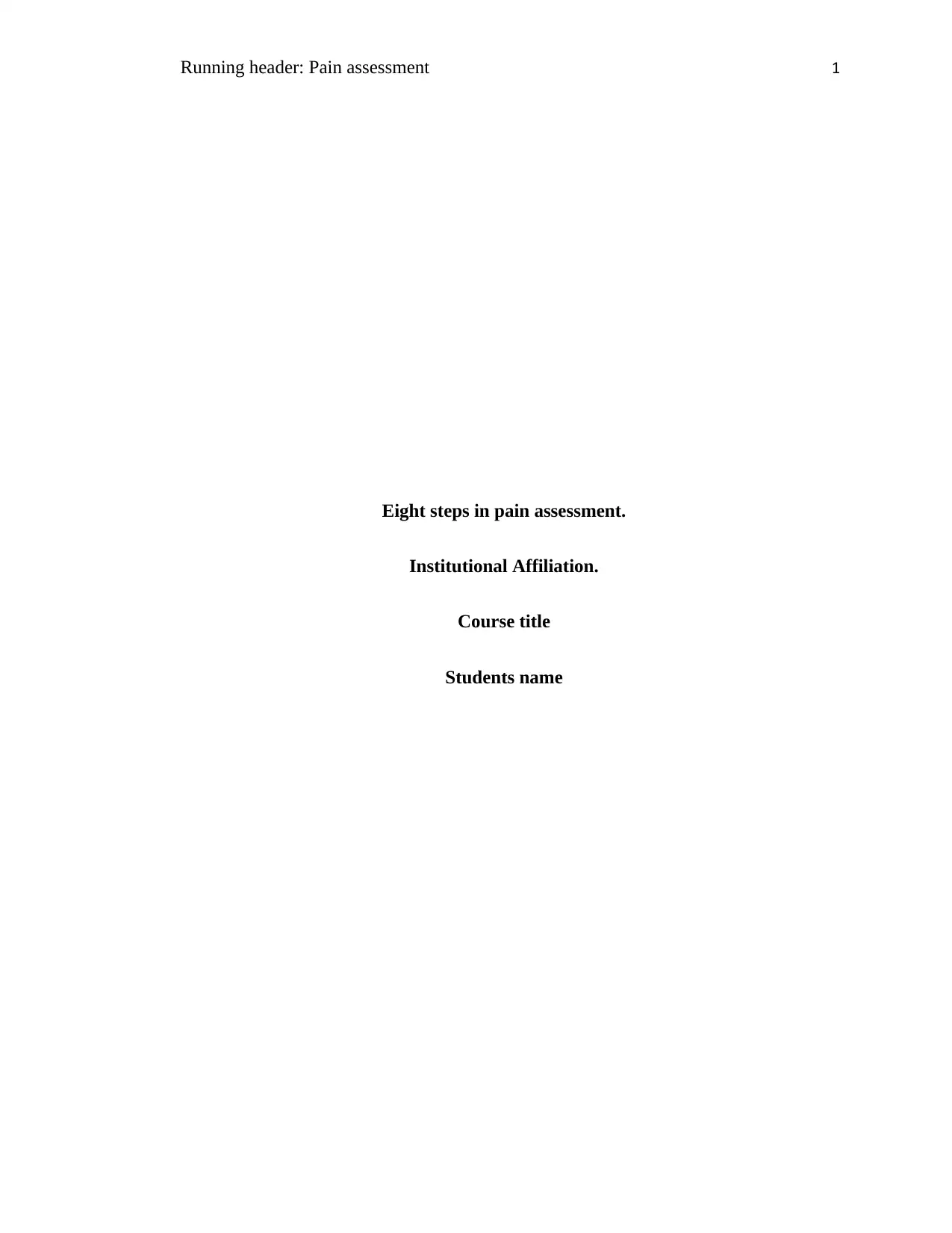
Running header: Pain assessment 1
Eight steps in pain assessment.
Institutional Affiliation.
Course title
Students name
Eight steps in pain assessment.
Institutional Affiliation.
Course title
Students name
Paraphrase This Document
Need a fresh take? Get an instant paraphrase of this document with our AI Paraphraser
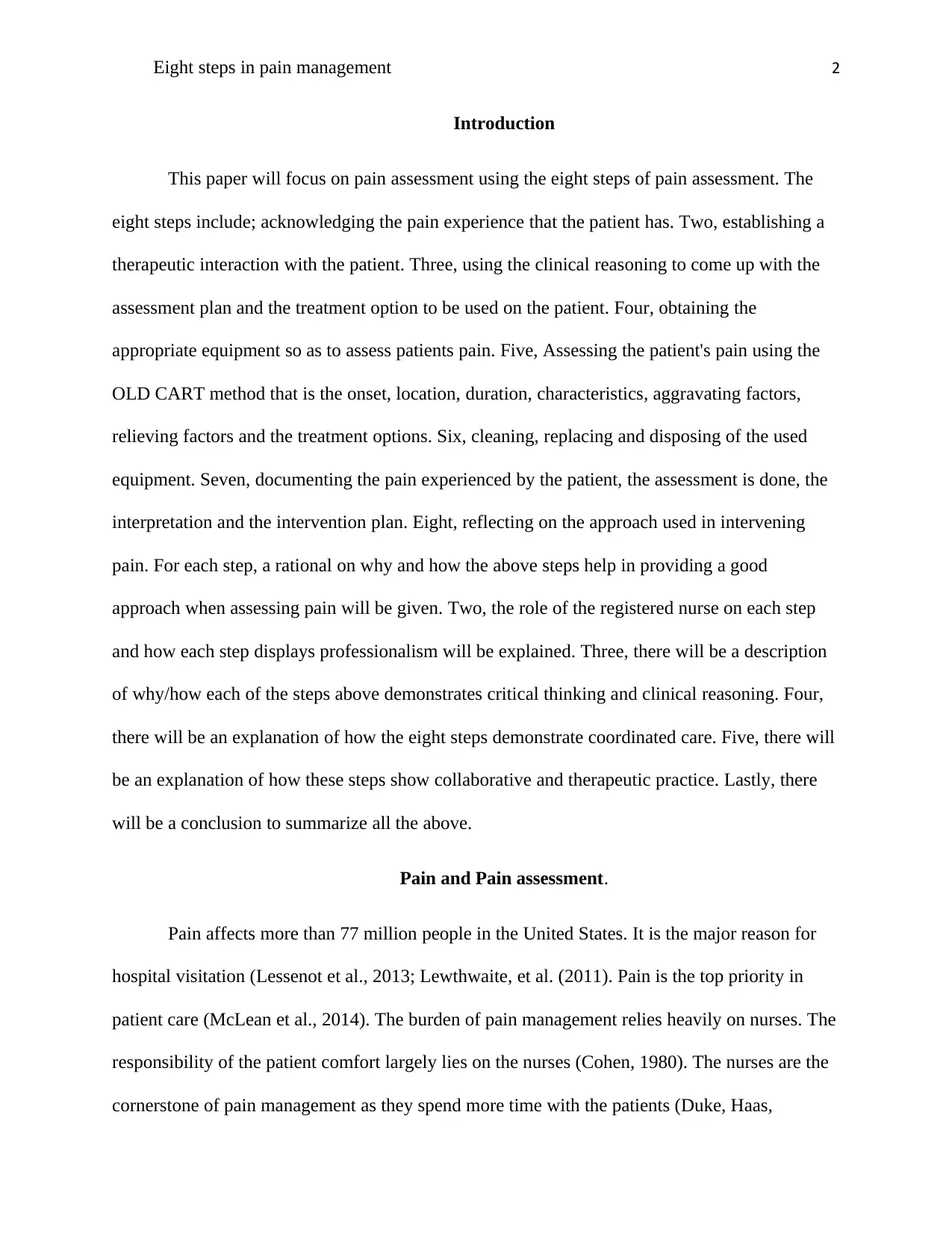
Eight steps in pain management 2
Introduction
This paper will focus on pain assessment using the eight steps of pain assessment. The
eight steps include; acknowledging the pain experience that the patient has. Two, establishing a
therapeutic interaction with the patient. Three, using the clinical reasoning to come up with the
assessment plan and the treatment option to be used on the patient. Four, obtaining the
appropriate equipment so as to assess patients pain. Five, Assessing the patient's pain using the
OLD CART method that is the onset, location, duration, characteristics, aggravating factors,
relieving factors and the treatment options. Six, cleaning, replacing and disposing of the used
equipment. Seven, documenting the pain experienced by the patient, the assessment is done, the
interpretation and the intervention plan. Eight, reflecting on the approach used in intervening
pain. For each step, a rational on why and how the above steps help in providing a good
approach when assessing pain will be given. Two, the role of the registered nurse on each step
and how each step displays professionalism will be explained. Three, there will be a description
of why/how each of the steps above demonstrates critical thinking and clinical reasoning. Four,
there will be an explanation of how the eight steps demonstrate coordinated care. Five, there will
be an explanation of how these steps show collaborative and therapeutic practice. Lastly, there
will be a conclusion to summarize all the above.
Pain and Pain assessment.
Pain affects more than 77 million people in the United States. It is the major reason for
hospital visitation (Lessenot et al., 2013; Lewthwaite, et al. (2011). Pain is the top priority in
patient care (McLean et al., 2014). The burden of pain management relies heavily on nurses. The
responsibility of the patient comfort largely lies on the nurses (Cohen, 1980). The nurses are the
cornerstone of pain management as they spend more time with the patients (Duke, Haas,
Introduction
This paper will focus on pain assessment using the eight steps of pain assessment. The
eight steps include; acknowledging the pain experience that the patient has. Two, establishing a
therapeutic interaction with the patient. Three, using the clinical reasoning to come up with the
assessment plan and the treatment option to be used on the patient. Four, obtaining the
appropriate equipment so as to assess patients pain. Five, Assessing the patient's pain using the
OLD CART method that is the onset, location, duration, characteristics, aggravating factors,
relieving factors and the treatment options. Six, cleaning, replacing and disposing of the used
equipment. Seven, documenting the pain experienced by the patient, the assessment is done, the
interpretation and the intervention plan. Eight, reflecting on the approach used in intervening
pain. For each step, a rational on why and how the above steps help in providing a good
approach when assessing pain will be given. Two, the role of the registered nurse on each step
and how each step displays professionalism will be explained. Three, there will be a description
of why/how each of the steps above demonstrates critical thinking and clinical reasoning. Four,
there will be an explanation of how the eight steps demonstrate coordinated care. Five, there will
be an explanation of how these steps show collaborative and therapeutic practice. Lastly, there
will be a conclusion to summarize all the above.
Pain and Pain assessment.
Pain affects more than 77 million people in the United States. It is the major reason for
hospital visitation (Lessenot et al., 2013; Lewthwaite, et al. (2011). Pain is the top priority in
patient care (McLean et al., 2014). The burden of pain management relies heavily on nurses. The
responsibility of the patient comfort largely lies on the nurses (Cohen, 1980). The nurses are the
cornerstone of pain management as they spend more time with the patients (Duke, Haas,
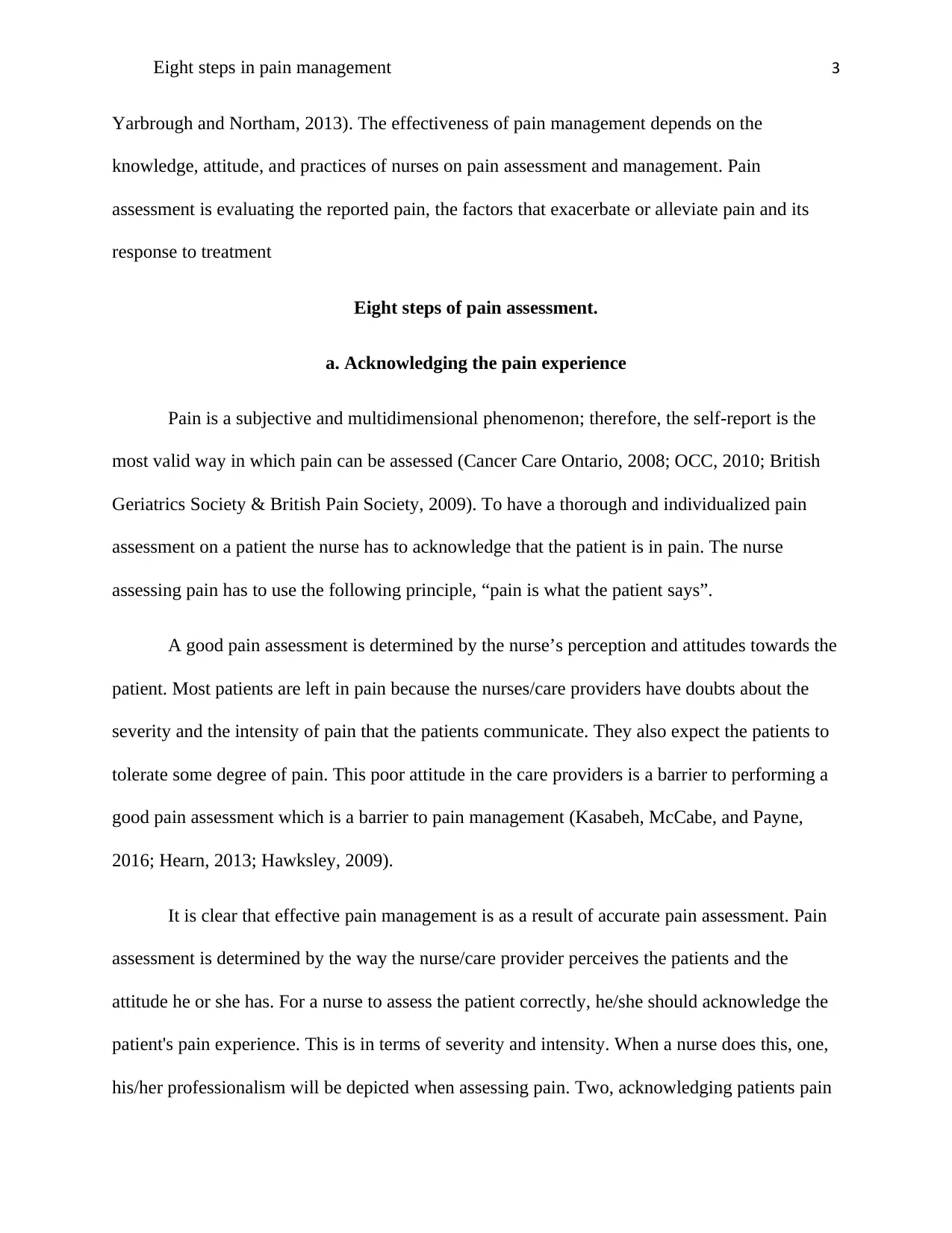
Eight steps in pain management 3
Yarbrough and Northam, 2013). The effectiveness of pain management depends on the
knowledge, attitude, and practices of nurses on pain assessment and management. Pain
assessment is evaluating the reported pain, the factors that exacerbate or alleviate pain and its
response to treatment
Eight steps of pain assessment.
a. Acknowledging the pain experience
Pain is a subjective and multidimensional phenomenon; therefore, the self-report is the
most valid way in which pain can be assessed (Cancer Care Ontario, 2008; OCC, 2010; British
Geriatrics Society & British Pain Society, 2009). To have a thorough and individualized pain
assessment on a patient the nurse has to acknowledge that the patient is in pain. The nurse
assessing pain has to use the following principle, “pain is what the patient says”.
A good pain assessment is determined by the nurse’s perception and attitudes towards the
patient. Most patients are left in pain because the nurses/care providers have doubts about the
severity and the intensity of pain that the patients communicate. They also expect the patients to
tolerate some degree of pain. This poor attitude in the care providers is a barrier to performing a
good pain assessment which is a barrier to pain management (Kasabeh, McCabe, and Payne,
2016; Hearn, 2013; Hawksley, 2009).
It is clear that effective pain management is as a result of accurate pain assessment. Pain
assessment is determined by the way the nurse/care provider perceives the patients and the
attitude he or she has. For a nurse to assess the patient correctly, he/she should acknowledge the
patient's pain experience. This is in terms of severity and intensity. When a nurse does this, one,
his/her professionalism will be depicted when assessing pain. Two, acknowledging patients pain
Yarbrough and Northam, 2013). The effectiveness of pain management depends on the
knowledge, attitude, and practices of nurses on pain assessment and management. Pain
assessment is evaluating the reported pain, the factors that exacerbate or alleviate pain and its
response to treatment
Eight steps of pain assessment.
a. Acknowledging the pain experience
Pain is a subjective and multidimensional phenomenon; therefore, the self-report is the
most valid way in which pain can be assessed (Cancer Care Ontario, 2008; OCC, 2010; British
Geriatrics Society & British Pain Society, 2009). To have a thorough and individualized pain
assessment on a patient the nurse has to acknowledge that the patient is in pain. The nurse
assessing pain has to use the following principle, “pain is what the patient says”.
A good pain assessment is determined by the nurse’s perception and attitudes towards the
patient. Most patients are left in pain because the nurses/care providers have doubts about the
severity and the intensity of pain that the patients communicate. They also expect the patients to
tolerate some degree of pain. This poor attitude in the care providers is a barrier to performing a
good pain assessment which is a barrier to pain management (Kasabeh, McCabe, and Payne,
2016; Hearn, 2013; Hawksley, 2009).
It is clear that effective pain management is as a result of accurate pain assessment. Pain
assessment is determined by the way the nurse/care provider perceives the patients and the
attitude he or she has. For a nurse to assess the patient correctly, he/she should acknowledge the
patient's pain experience. This is in terms of severity and intensity. When a nurse does this, one,
his/her professionalism will be depicted when assessing pain. Two, acknowledging patients pain
⊘ This is a preview!⊘
Do you want full access?
Subscribe today to unlock all pages.

Trusted by 1+ million students worldwide
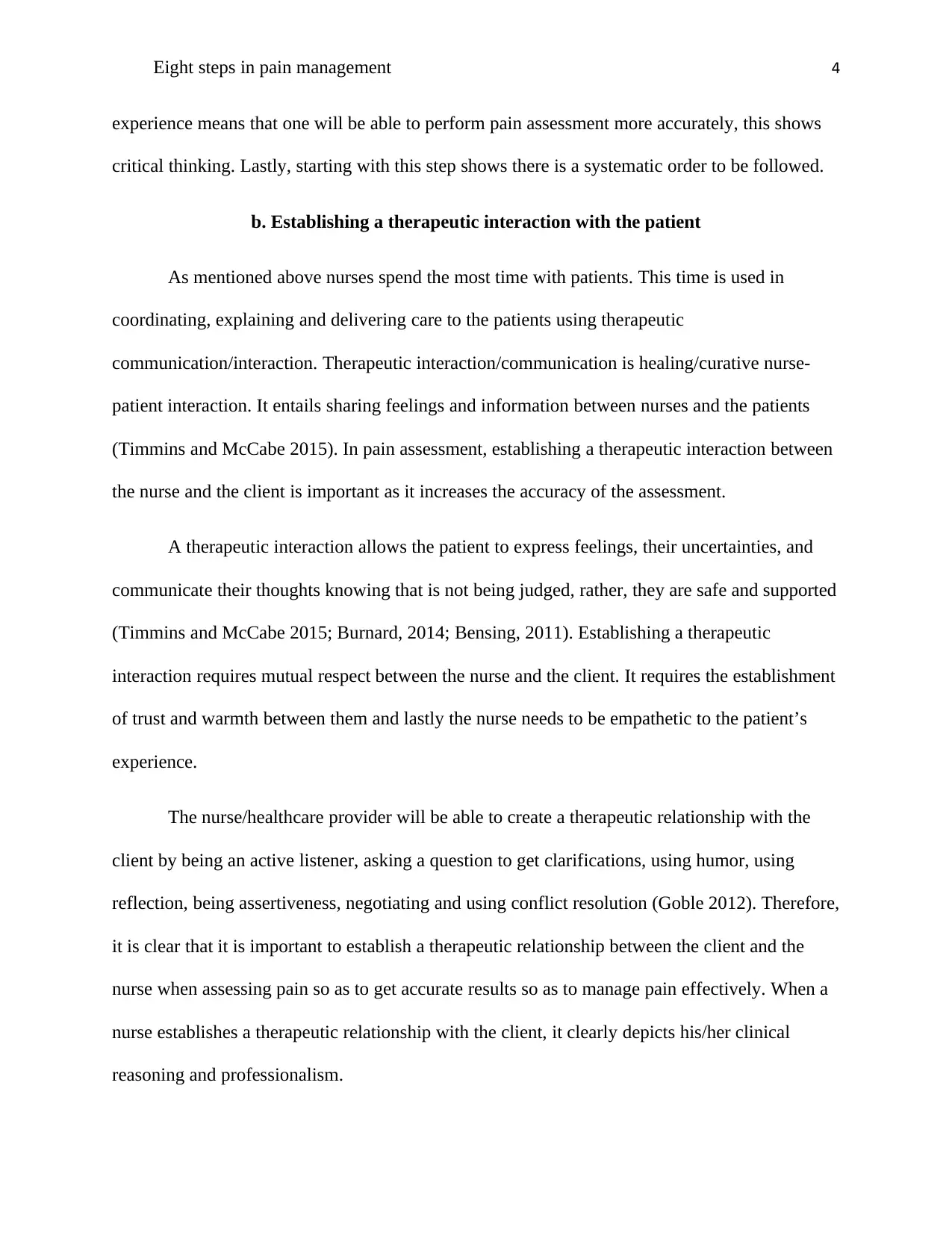
Eight steps in pain management 4
experience means that one will be able to perform pain assessment more accurately, this shows
critical thinking. Lastly, starting with this step shows there is a systematic order to be followed.
b. Establishing a therapeutic interaction with the patient
As mentioned above nurses spend the most time with patients. This time is used in
coordinating, explaining and delivering care to the patients using therapeutic
communication/interaction. Therapeutic interaction/communication is healing/curative nurse-
patient interaction. It entails sharing feelings and information between nurses and the patients
(Timmins and McCabe 2015). In pain assessment, establishing a therapeutic interaction between
the nurse and the client is important as it increases the accuracy of the assessment.
A therapeutic interaction allows the patient to express feelings, their uncertainties, and
communicate their thoughts knowing that is not being judged, rather, they are safe and supported
(Timmins and McCabe 2015; Burnard, 2014; Bensing, 2011). Establishing a therapeutic
interaction requires mutual respect between the nurse and the client. It requires the establishment
of trust and warmth between them and lastly the nurse needs to be empathetic to the patient’s
experience.
The nurse/healthcare provider will be able to create a therapeutic relationship with the
client by being an active listener, asking a question to get clarifications, using humor, using
reflection, being assertiveness, negotiating and using conflict resolution (Goble 2012). Therefore,
it is clear that it is important to establish a therapeutic relationship between the client and the
nurse when assessing pain so as to get accurate results so as to manage pain effectively. When a
nurse establishes a therapeutic relationship with the client, it clearly depicts his/her clinical
reasoning and professionalism.
experience means that one will be able to perform pain assessment more accurately, this shows
critical thinking. Lastly, starting with this step shows there is a systematic order to be followed.
b. Establishing a therapeutic interaction with the patient
As mentioned above nurses spend the most time with patients. This time is used in
coordinating, explaining and delivering care to the patients using therapeutic
communication/interaction. Therapeutic interaction/communication is healing/curative nurse-
patient interaction. It entails sharing feelings and information between nurses and the patients
(Timmins and McCabe 2015). In pain assessment, establishing a therapeutic interaction between
the nurse and the client is important as it increases the accuracy of the assessment.
A therapeutic interaction allows the patient to express feelings, their uncertainties, and
communicate their thoughts knowing that is not being judged, rather, they are safe and supported
(Timmins and McCabe 2015; Burnard, 2014; Bensing, 2011). Establishing a therapeutic
interaction requires mutual respect between the nurse and the client. It requires the establishment
of trust and warmth between them and lastly the nurse needs to be empathetic to the patient’s
experience.
The nurse/healthcare provider will be able to create a therapeutic relationship with the
client by being an active listener, asking a question to get clarifications, using humor, using
reflection, being assertiveness, negotiating and using conflict resolution (Goble 2012). Therefore,
it is clear that it is important to establish a therapeutic relationship between the client and the
nurse when assessing pain so as to get accurate results so as to manage pain effectively. When a
nurse establishes a therapeutic relationship with the client, it clearly depicts his/her clinical
reasoning and professionalism.
Paraphrase This Document
Need a fresh take? Get an instant paraphrase of this document with our AI Paraphraser
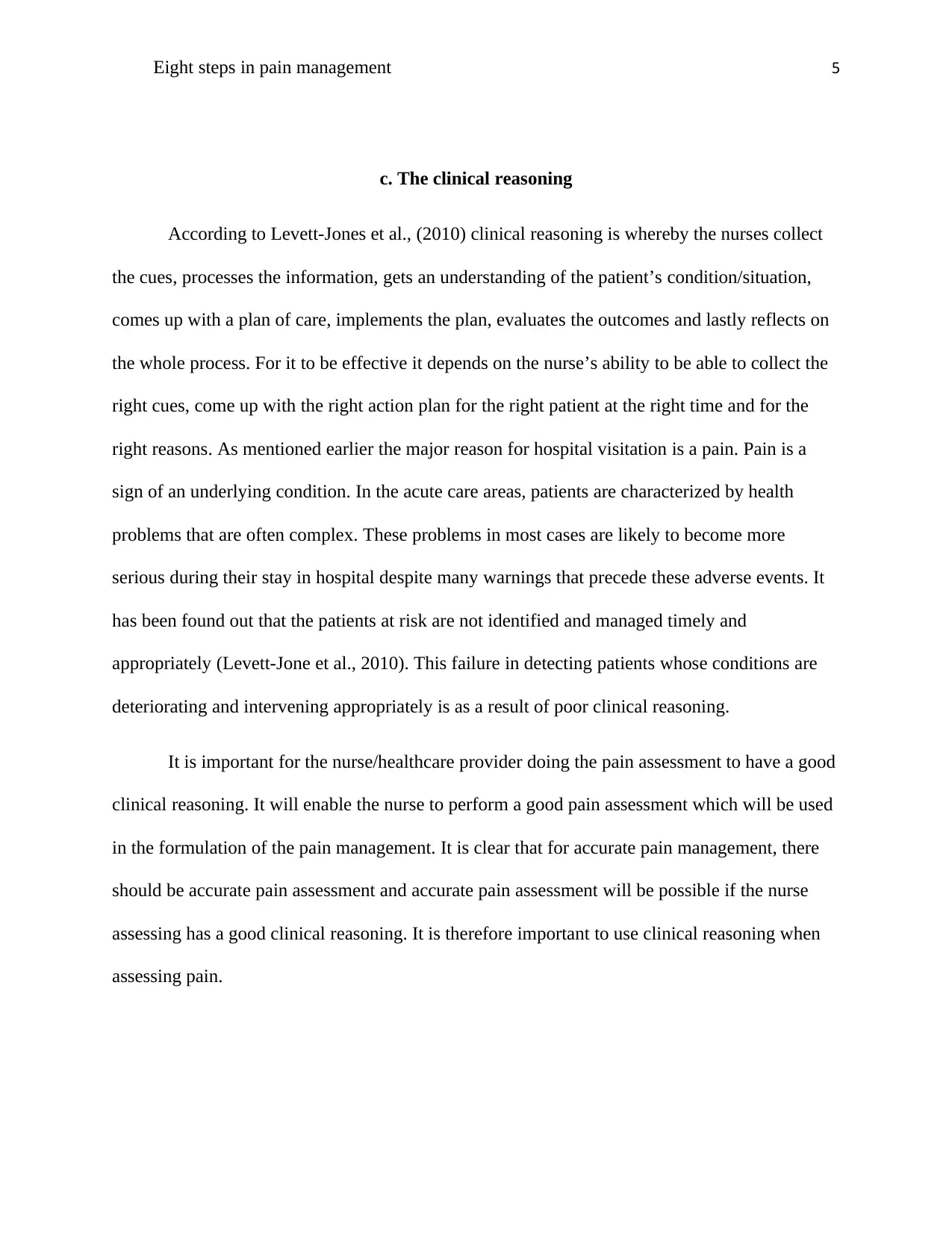
Eight steps in pain management 5
c. The clinical reasoning
According to Levett-Jones et al., (2010) clinical reasoning is whereby the nurses collect
the cues, processes the information, gets an understanding of the patient’s condition/situation,
comes up with a plan of care, implements the plan, evaluates the outcomes and lastly reflects on
the whole process. For it to be effective it depends on the nurse’s ability to be able to collect the
right cues, come up with the right action plan for the right patient at the right time and for the
right reasons. As mentioned earlier the major reason for hospital visitation is a pain. Pain is a
sign of an underlying condition. In the acute care areas, patients are characterized by health
problems that are often complex. These problems in most cases are likely to become more
serious during their stay in hospital despite many warnings that precede these adverse events. It
has been found out that the patients at risk are not identified and managed timely and
appropriately (Levett-Jone et al., 2010). This failure in detecting patients whose conditions are
deteriorating and intervening appropriately is as a result of poor clinical reasoning.
It is important for the nurse/healthcare provider doing the pain assessment to have a good
clinical reasoning. It will enable the nurse to perform a good pain assessment which will be used
in the formulation of the pain management. It is clear that for accurate pain management, there
should be accurate pain assessment and accurate pain assessment will be possible if the nurse
assessing has a good clinical reasoning. It is therefore important to use clinical reasoning when
assessing pain.
c. The clinical reasoning
According to Levett-Jones et al., (2010) clinical reasoning is whereby the nurses collect
the cues, processes the information, gets an understanding of the patient’s condition/situation,
comes up with a plan of care, implements the plan, evaluates the outcomes and lastly reflects on
the whole process. For it to be effective it depends on the nurse’s ability to be able to collect the
right cues, come up with the right action plan for the right patient at the right time and for the
right reasons. As mentioned earlier the major reason for hospital visitation is a pain. Pain is a
sign of an underlying condition. In the acute care areas, patients are characterized by health
problems that are often complex. These problems in most cases are likely to become more
serious during their stay in hospital despite many warnings that precede these adverse events. It
has been found out that the patients at risk are not identified and managed timely and
appropriately (Levett-Jone et al., 2010). This failure in detecting patients whose conditions are
deteriorating and intervening appropriately is as a result of poor clinical reasoning.
It is important for the nurse/healthcare provider doing the pain assessment to have a good
clinical reasoning. It will enable the nurse to perform a good pain assessment which will be used
in the formulation of the pain management. It is clear that for accurate pain management, there
should be accurate pain assessment and accurate pain assessment will be possible if the nurse
assessing has a good clinical reasoning. It is therefore important to use clinical reasoning when
assessing pain.
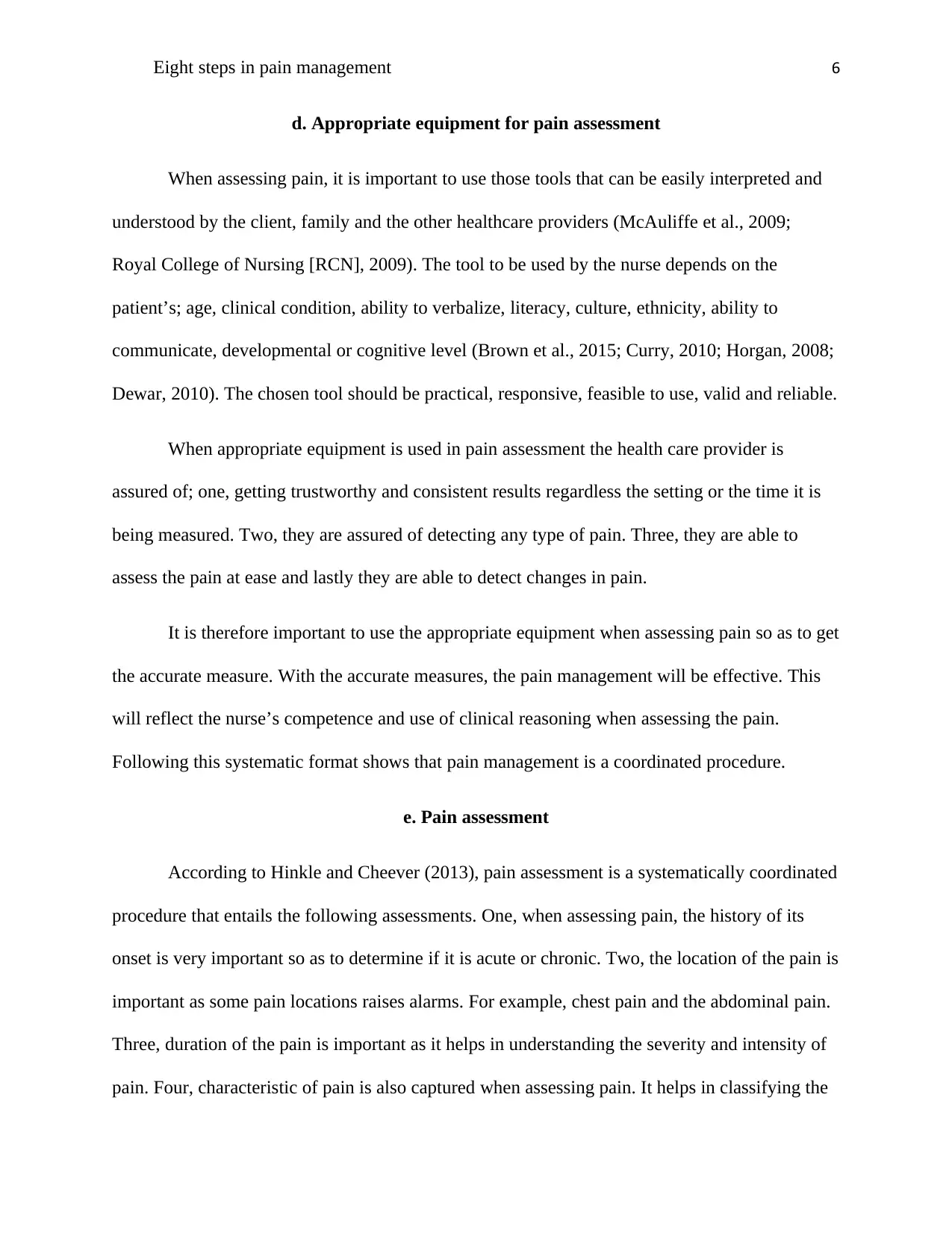
Eight steps in pain management 6
d. Appropriate equipment for pain assessment
When assessing pain, it is important to use those tools that can be easily interpreted and
understood by the client, family and the other healthcare providers (McAuliffe et al., 2009;
Royal College of Nursing [RCN], 2009). The tool to be used by the nurse depends on the
patient’s; age, clinical condition, ability to verbalize, literacy, culture, ethnicity, ability to
communicate, developmental or cognitive level (Brown et al., 2015; Curry, 2010; Horgan, 2008;
Dewar, 2010). The chosen tool should be practical, responsive, feasible to use, valid and reliable.
When appropriate equipment is used in pain assessment the health care provider is
assured of; one, getting trustworthy and consistent results regardless the setting or the time it is
being measured. Two, they are assured of detecting any type of pain. Three, they are able to
assess the pain at ease and lastly they are able to detect changes in pain.
It is therefore important to use the appropriate equipment when assessing pain so as to get
the accurate measure. With the accurate measures, the pain management will be effective. This
will reflect the nurse’s competence and use of clinical reasoning when assessing the pain.
Following this systematic format shows that pain management is a coordinated procedure.
e. Pain assessment
According to Hinkle and Cheever (2013), pain assessment is a systematically coordinated
procedure that entails the following assessments. One, when assessing pain, the history of its
onset is very important so as to determine if it is acute or chronic. Two, the location of the pain is
important as some pain locations raises alarms. For example, chest pain and the abdominal pain.
Three, duration of the pain is important as it helps in understanding the severity and intensity of
pain. Four, characteristic of pain is also captured when assessing pain. It helps in classifying the
d. Appropriate equipment for pain assessment
When assessing pain, it is important to use those tools that can be easily interpreted and
understood by the client, family and the other healthcare providers (McAuliffe et al., 2009;
Royal College of Nursing [RCN], 2009). The tool to be used by the nurse depends on the
patient’s; age, clinical condition, ability to verbalize, literacy, culture, ethnicity, ability to
communicate, developmental or cognitive level (Brown et al., 2015; Curry, 2010; Horgan, 2008;
Dewar, 2010). The chosen tool should be practical, responsive, feasible to use, valid and reliable.
When appropriate equipment is used in pain assessment the health care provider is
assured of; one, getting trustworthy and consistent results regardless the setting or the time it is
being measured. Two, they are assured of detecting any type of pain. Three, they are able to
assess the pain at ease and lastly they are able to detect changes in pain.
It is therefore important to use the appropriate equipment when assessing pain so as to get
the accurate measure. With the accurate measures, the pain management will be effective. This
will reflect the nurse’s competence and use of clinical reasoning when assessing the pain.
Following this systematic format shows that pain management is a coordinated procedure.
e. Pain assessment
According to Hinkle and Cheever (2013), pain assessment is a systematically coordinated
procedure that entails the following assessments. One, when assessing pain, the history of its
onset is very important so as to determine if it is acute or chronic. Two, the location of the pain is
important as some pain locations raises alarms. For example, chest pain and the abdominal pain.
Three, duration of the pain is important as it helps in understanding the severity and intensity of
pain. Four, characteristic of pain is also captured when assessing pain. It helps in classifying the
⊘ This is a preview!⊘
Do you want full access?
Subscribe today to unlock all pages.

Trusted by 1+ million students worldwide
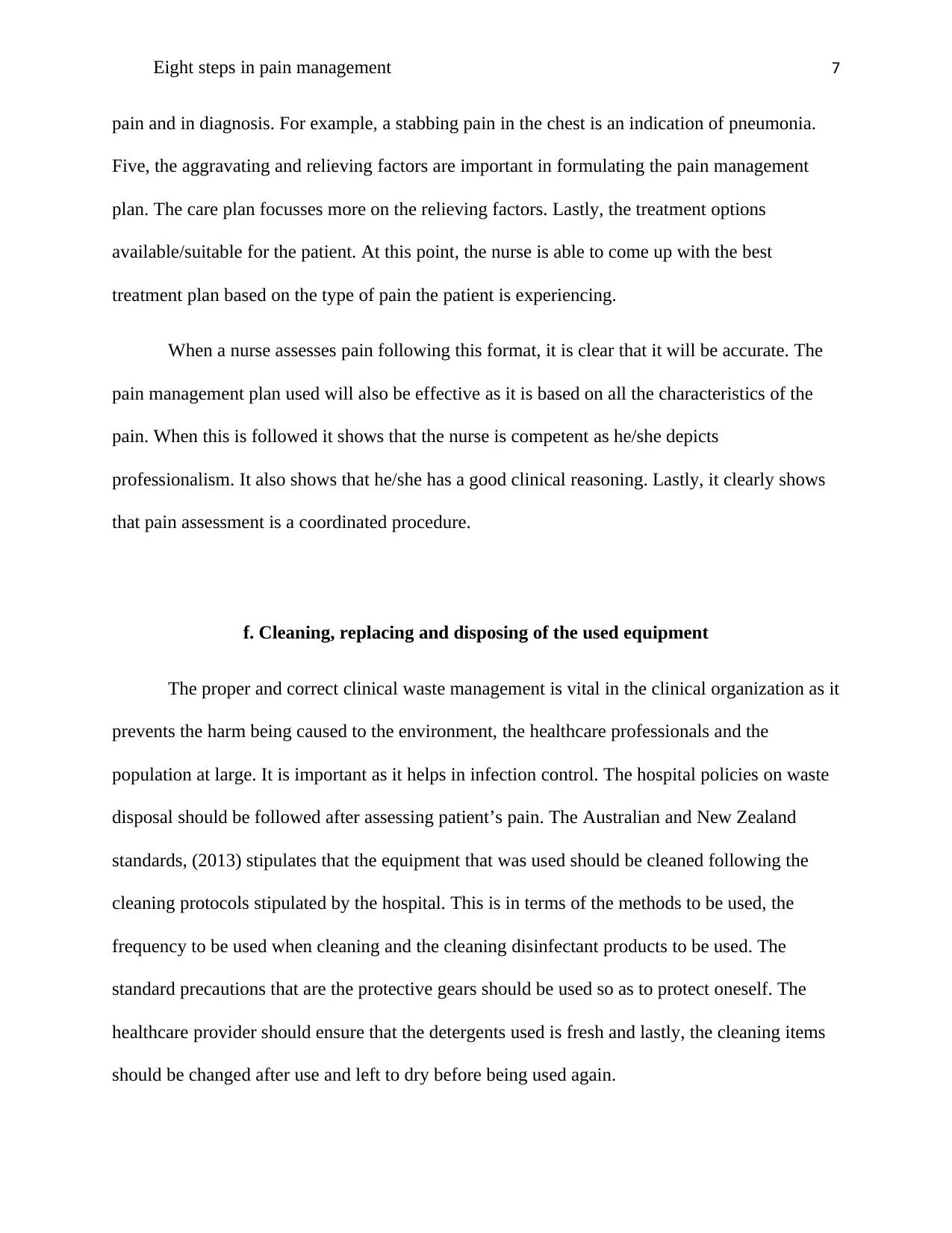
Eight steps in pain management 7
pain and in diagnosis. For example, a stabbing pain in the chest is an indication of pneumonia.
Five, the aggravating and relieving factors are important in formulating the pain management
plan. The care plan focusses more on the relieving factors. Lastly, the treatment options
available/suitable for the patient. At this point, the nurse is able to come up with the best
treatment plan based on the type of pain the patient is experiencing.
When a nurse assesses pain following this format, it is clear that it will be accurate. The
pain management plan used will also be effective as it is based on all the characteristics of the
pain. When this is followed it shows that the nurse is competent as he/she depicts
professionalism. It also shows that he/she has a good clinical reasoning. Lastly, it clearly shows
that pain assessment is a coordinated procedure.
f. Cleaning, replacing and disposing of the used equipment
The proper and correct clinical waste management is vital in the clinical organization as it
prevents the harm being caused to the environment, the healthcare professionals and the
population at large. It is important as it helps in infection control. The hospital policies on waste
disposal should be followed after assessing patient’s pain. The Australian and New Zealand
standards, (2013) stipulates that the equipment that was used should be cleaned following the
cleaning protocols stipulated by the hospital. This is in terms of the methods to be used, the
frequency to be used when cleaning and the cleaning disinfectant products to be used. The
standard precautions that are the protective gears should be used so as to protect oneself. The
healthcare provider should ensure that the detergents used is fresh and lastly, the cleaning items
should be changed after use and left to dry before being used again.
pain and in diagnosis. For example, a stabbing pain in the chest is an indication of pneumonia.
Five, the aggravating and relieving factors are important in formulating the pain management
plan. The care plan focusses more on the relieving factors. Lastly, the treatment options
available/suitable for the patient. At this point, the nurse is able to come up with the best
treatment plan based on the type of pain the patient is experiencing.
When a nurse assesses pain following this format, it is clear that it will be accurate. The
pain management plan used will also be effective as it is based on all the characteristics of the
pain. When this is followed it shows that the nurse is competent as he/she depicts
professionalism. It also shows that he/she has a good clinical reasoning. Lastly, it clearly shows
that pain assessment is a coordinated procedure.
f. Cleaning, replacing and disposing of the used equipment
The proper and correct clinical waste management is vital in the clinical organization as it
prevents the harm being caused to the environment, the healthcare professionals and the
population at large. It is important as it helps in infection control. The hospital policies on waste
disposal should be followed after assessing patient’s pain. The Australian and New Zealand
standards, (2013) stipulates that the equipment that was used should be cleaned following the
cleaning protocols stipulated by the hospital. This is in terms of the methods to be used, the
frequency to be used when cleaning and the cleaning disinfectant products to be used. The
standard precautions that are the protective gears should be used so as to protect oneself. The
healthcare provider should ensure that the detergents used is fresh and lastly, the cleaning items
should be changed after use and left to dry before being used again.
Paraphrase This Document
Need a fresh take? Get an instant paraphrase of this document with our AI Paraphraser
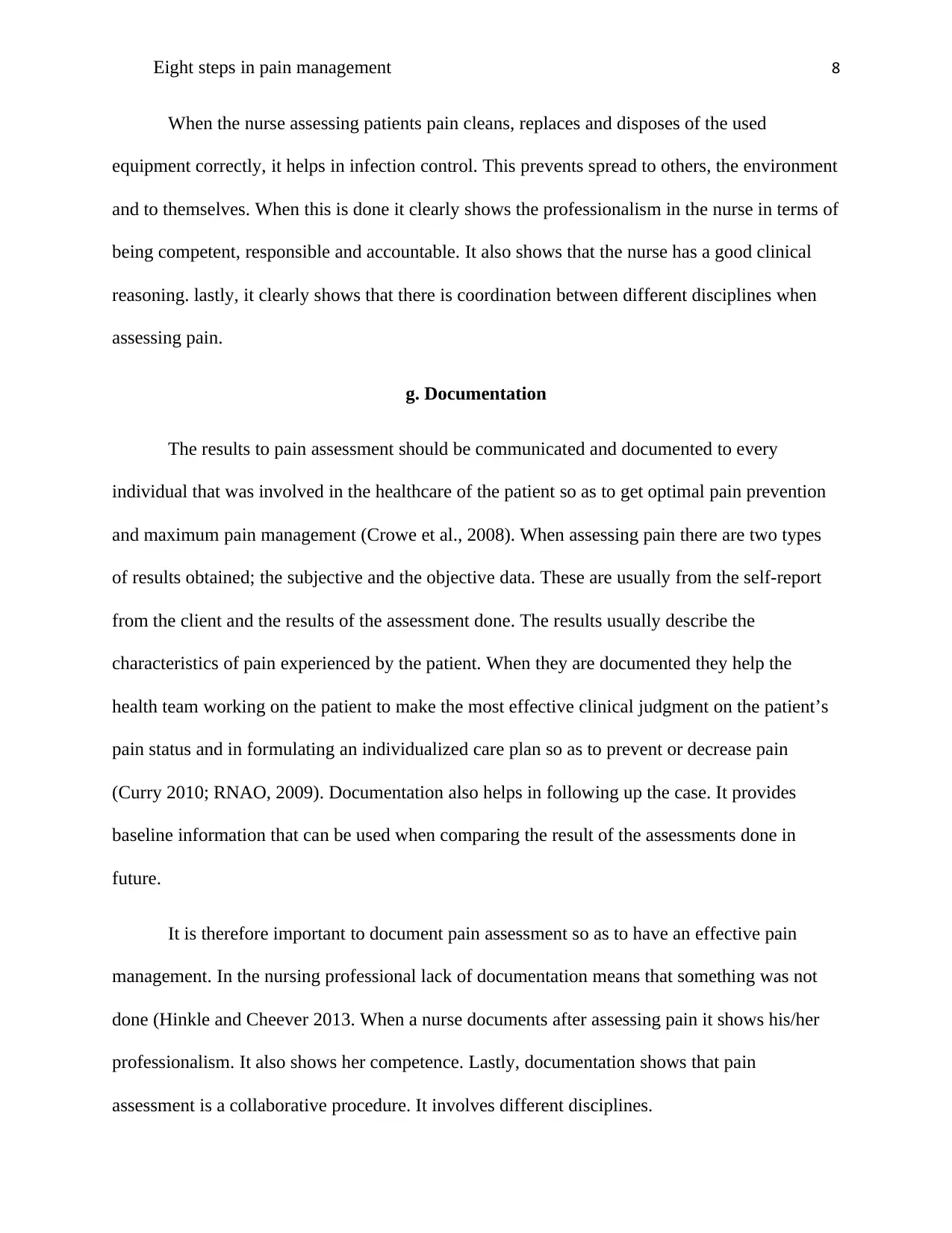
Eight steps in pain management 8
When the nurse assessing patients pain cleans, replaces and disposes of the used
equipment correctly, it helps in infection control. This prevents spread to others, the environment
and to themselves. When this is done it clearly shows the professionalism in the nurse in terms of
being competent, responsible and accountable. It also shows that the nurse has a good clinical
reasoning. lastly, it clearly shows that there is coordination between different disciplines when
assessing pain.
g. Documentation
The results to pain assessment should be communicated and documented to every
individual that was involved in the healthcare of the patient so as to get optimal pain prevention
and maximum pain management (Crowe et al., 2008). When assessing pain there are two types
of results obtained; the subjective and the objective data. These are usually from the self-report
from the client and the results of the assessment done. The results usually describe the
characteristics of pain experienced by the patient. When they are documented they help the
health team working on the patient to make the most effective clinical judgment on the patient’s
pain status and in formulating an individualized care plan so as to prevent or decrease pain
(Curry 2010; RNAO, 2009). Documentation also helps in following up the case. It provides
baseline information that can be used when comparing the result of the assessments done in
future.
It is therefore important to document pain assessment so as to have an effective pain
management. In the nursing professional lack of documentation means that something was not
done (Hinkle and Cheever 2013. When a nurse documents after assessing pain it shows his/her
professionalism. It also shows her competence. Lastly, documentation shows that pain
assessment is a collaborative procedure. It involves different disciplines.
When the nurse assessing patients pain cleans, replaces and disposes of the used
equipment correctly, it helps in infection control. This prevents spread to others, the environment
and to themselves. When this is done it clearly shows the professionalism in the nurse in terms of
being competent, responsible and accountable. It also shows that the nurse has a good clinical
reasoning. lastly, it clearly shows that there is coordination between different disciplines when
assessing pain.
g. Documentation
The results to pain assessment should be communicated and documented to every
individual that was involved in the healthcare of the patient so as to get optimal pain prevention
and maximum pain management (Crowe et al., 2008). When assessing pain there are two types
of results obtained; the subjective and the objective data. These are usually from the self-report
from the client and the results of the assessment done. The results usually describe the
characteristics of pain experienced by the patient. When they are documented they help the
health team working on the patient to make the most effective clinical judgment on the patient’s
pain status and in formulating an individualized care plan so as to prevent or decrease pain
(Curry 2010; RNAO, 2009). Documentation also helps in following up the case. It provides
baseline information that can be used when comparing the result of the assessments done in
future.
It is therefore important to document pain assessment so as to have an effective pain
management. In the nursing professional lack of documentation means that something was not
done (Hinkle and Cheever 2013. When a nurse documents after assessing pain it shows his/her
professionalism. It also shows her competence. Lastly, documentation shows that pain
assessment is a collaborative procedure. It involves different disciplines.
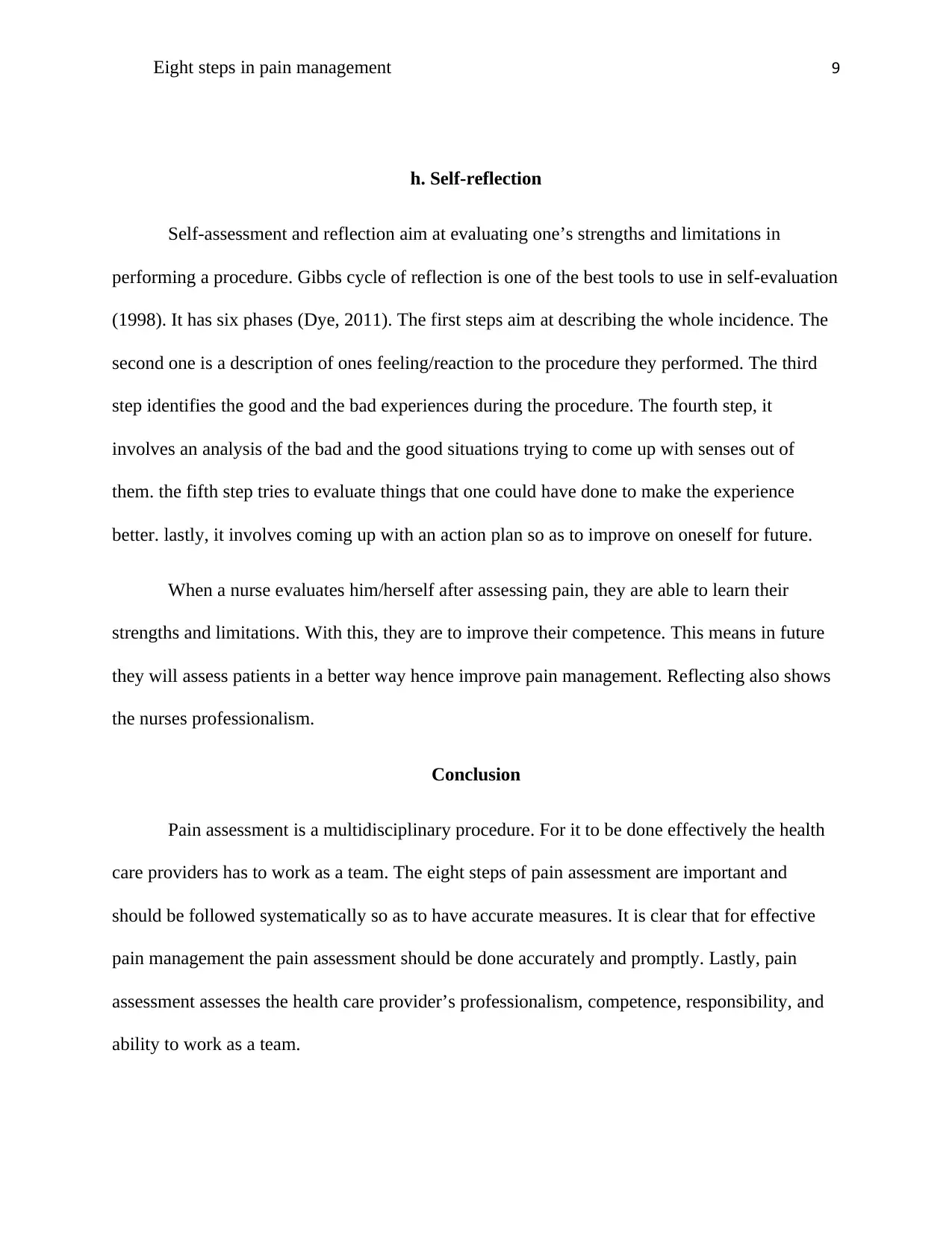
Eight steps in pain management 9
h. Self-reflection
Self-assessment and reflection aim at evaluating one’s strengths and limitations in
performing a procedure. Gibbs cycle of reflection is one of the best tools to use in self-evaluation
(1998). It has six phases (Dye, 2011). The first steps aim at describing the whole incidence. The
second one is a description of ones feeling/reaction to the procedure they performed. The third
step identifies the good and the bad experiences during the procedure. The fourth step, it
involves an analysis of the bad and the good situations trying to come up with senses out of
them. the fifth step tries to evaluate things that one could have done to make the experience
better. lastly, it involves coming up with an action plan so as to improve on oneself for future.
When a nurse evaluates him/herself after assessing pain, they are able to learn their
strengths and limitations. With this, they are to improve their competence. This means in future
they will assess patients in a better way hence improve pain management. Reflecting also shows
the nurses professionalism.
Conclusion
Pain assessment is a multidisciplinary procedure. For it to be done effectively the health
care providers has to work as a team. The eight steps of pain assessment are important and
should be followed systematically so as to have accurate measures. It is clear that for effective
pain management the pain assessment should be done accurately and promptly. Lastly, pain
assessment assesses the health care provider’s professionalism, competence, responsibility, and
ability to work as a team.
h. Self-reflection
Self-assessment and reflection aim at evaluating one’s strengths and limitations in
performing a procedure. Gibbs cycle of reflection is one of the best tools to use in self-evaluation
(1998). It has six phases (Dye, 2011). The first steps aim at describing the whole incidence. The
second one is a description of ones feeling/reaction to the procedure they performed. The third
step identifies the good and the bad experiences during the procedure. The fourth step, it
involves an analysis of the bad and the good situations trying to come up with senses out of
them. the fifth step tries to evaluate things that one could have done to make the experience
better. lastly, it involves coming up with an action plan so as to improve on oneself for future.
When a nurse evaluates him/herself after assessing pain, they are able to learn their
strengths and limitations. With this, they are to improve their competence. This means in future
they will assess patients in a better way hence improve pain management. Reflecting also shows
the nurses professionalism.
Conclusion
Pain assessment is a multidisciplinary procedure. For it to be done effectively the health
care providers has to work as a team. The eight steps of pain assessment are important and
should be followed systematically so as to have accurate measures. It is clear that for effective
pain management the pain assessment should be done accurately and promptly. Lastly, pain
assessment assesses the health care provider’s professionalism, competence, responsibility, and
ability to work as a team.
⊘ This is a preview!⊘
Do you want full access?
Subscribe today to unlock all pages.

Trusted by 1+ million students worldwide
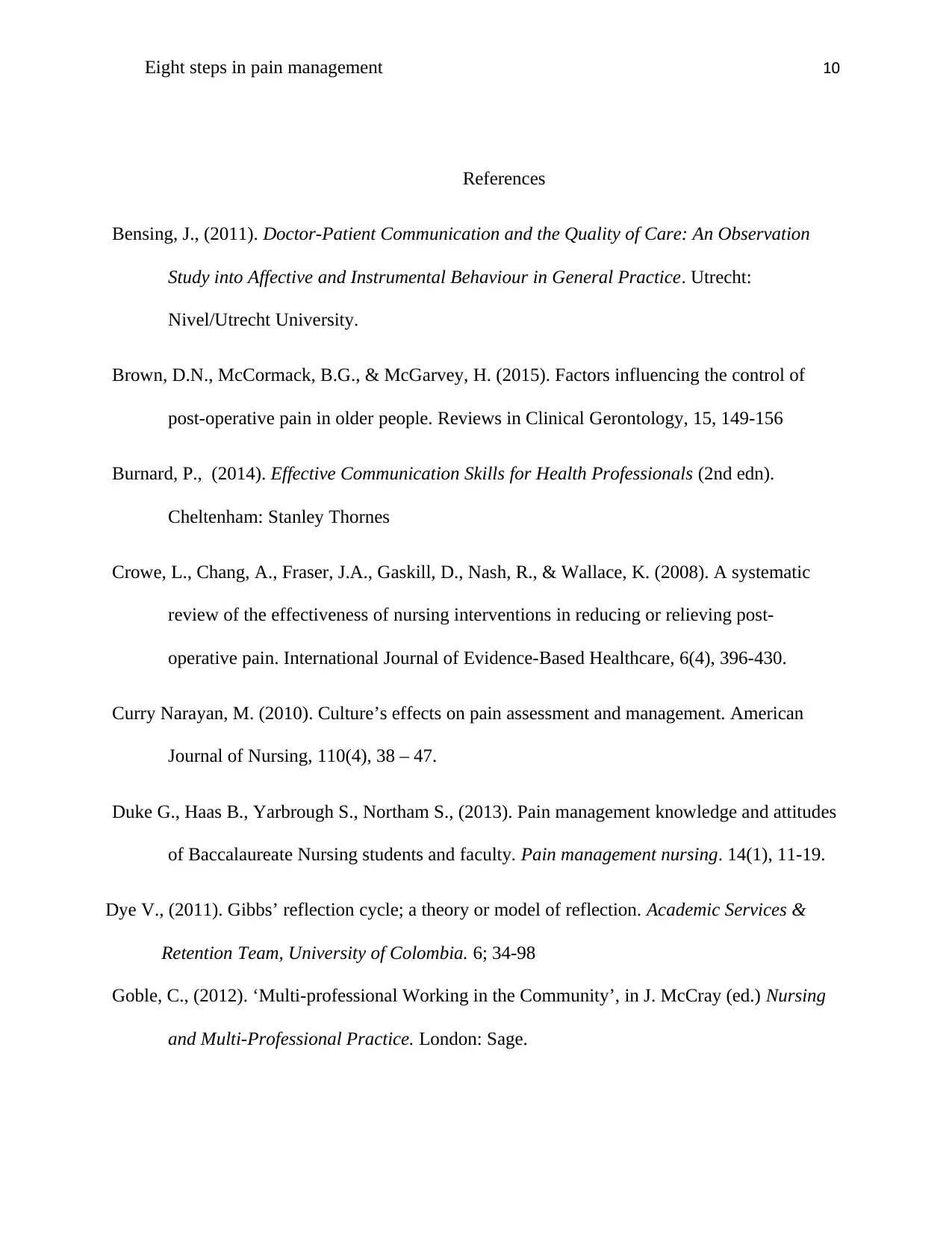
Eight steps in pain management 10
References
Bensing, J., (2011). Doctor-Patient Communication and the Quality of Care: An Observation
Study into Affective and Instrumental Behaviour in General Practice. Utrecht:
Nivel/Utrecht University.
Brown, D.N., McCormack, B.G., & McGarvey, H. (2015). Factors influencing the control of
post-operative pain in older people. Reviews in Clinical Gerontology, 15, 149-156
Burnard, P., (2014). Effective Communication Skills for Health Professionals (2nd edn).
Cheltenham: Stanley Thornes
Crowe, L., Chang, A., Fraser, J.A., Gaskill, D., Nash, R., & Wallace, K. (2008). A systematic
review of the effectiveness of nursing interventions in reducing or relieving post-
operative pain. International Journal of Evidence-Based Healthcare, 6(4), 396-430.
Curry Narayan, M. (2010). Culture’s effects on pain assessment and management. American
Journal of Nursing, 110(4), 38 – 47.
Duke G., Haas B., Yarbrough S., Northam S., (2013). Pain management knowledge and attitudes
of Baccalaureate Nursing students and faculty. Pain management nursing. 14(1), 11-19.
Dye V., (2011). Gibbs’ reflection cycle; a theory or model of reflection. Academic Services &
Retention Team, University of Colombia. 6; 34-98
Goble, C., (2012). ‘Multi-professional Working in the Community’, in J. McCray (ed.) Nursing
and Multi-Professional Practice. London: Sage.
References
Bensing, J., (2011). Doctor-Patient Communication and the Quality of Care: An Observation
Study into Affective and Instrumental Behaviour in General Practice. Utrecht:
Nivel/Utrecht University.
Brown, D.N., McCormack, B.G., & McGarvey, H. (2015). Factors influencing the control of
post-operative pain in older people. Reviews in Clinical Gerontology, 15, 149-156
Burnard, P., (2014). Effective Communication Skills for Health Professionals (2nd edn).
Cheltenham: Stanley Thornes
Crowe, L., Chang, A., Fraser, J.A., Gaskill, D., Nash, R., & Wallace, K. (2008). A systematic
review of the effectiveness of nursing interventions in reducing or relieving post-
operative pain. International Journal of Evidence-Based Healthcare, 6(4), 396-430.
Curry Narayan, M. (2010). Culture’s effects on pain assessment and management. American
Journal of Nursing, 110(4), 38 – 47.
Duke G., Haas B., Yarbrough S., Northam S., (2013). Pain management knowledge and attitudes
of Baccalaureate Nursing students and faculty. Pain management nursing. 14(1), 11-19.
Dye V., (2011). Gibbs’ reflection cycle; a theory or model of reflection. Academic Services &
Retention Team, University of Colombia. 6; 34-98
Goble, C., (2012). ‘Multi-professional Working in the Community’, in J. McCray (ed.) Nursing
and Multi-Professional Practice. London: Sage.
Paraphrase This Document
Need a fresh take? Get an instant paraphrase of this document with our AI Paraphraser
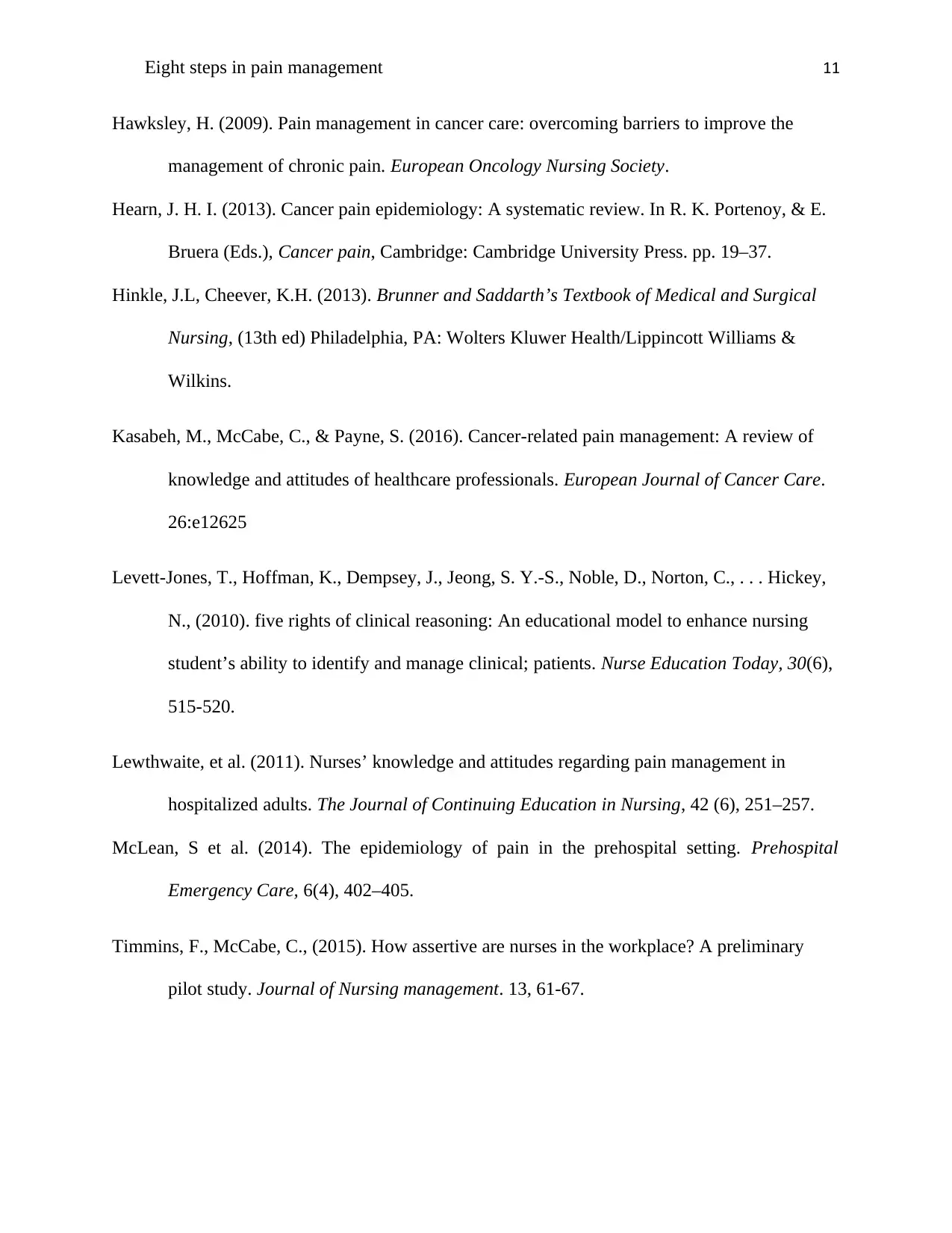
Eight steps in pain management 11
Hawksley, H. (2009). Pain management in cancer care: overcoming barriers to improve the
management of chronic pain. European Oncology Nursing Society.
Hearn, J. H. I. (2013). Cancer pain epidemiology: A systematic review. In R. K. Portenoy, & E.
Bruera (Eds.), Cancer pain, Cambridge: Cambridge University Press. pp. 19–37.
Hinkle, J.L, Cheever, K.H. (2013). Brunner and Saddarth’s Textbook of Medical and Surgical
Nursing, (13th ed) Philadelphia, PA: Wolters Kluwer Health/Lippincott Williams &
Wilkins.
Kasabeh, M., McCabe, C., & Payne, S. (2016). Cancer-related pain management: A review of
knowledge and attitudes of healthcare professionals. European Journal of Cancer Care.
26:e12625
Levett-Jones, T., Hoffman, K., Dempsey, J., Jeong, S. Y.-S., Noble, D., Norton, C., . . . Hickey,
N., (2010). five rights of clinical reasoning: An educational model to enhance nursing
student’s ability to identify and manage clinical; patients. Nurse Education Today, 30(6),
515-520.
Lewthwaite, et al. (2011). Nurses’ knowledge and attitudes regarding pain management in
hospitalized adults. The Journal of Continuing Education in Nursing, 42 (6), 251–257.
McLean, S et al. (2014). The epidemiology of pain in the prehospital setting. Prehospital
Emergency Care, 6(4), 402–405.
Timmins, F., McCabe, C., (2015). How assertive are nurses in the workplace? A preliminary
pilot study. Journal of Nursing management. 13, 61-67.
Hawksley, H. (2009). Pain management in cancer care: overcoming barriers to improve the
management of chronic pain. European Oncology Nursing Society.
Hearn, J. H. I. (2013). Cancer pain epidemiology: A systematic review. In R. K. Portenoy, & E.
Bruera (Eds.), Cancer pain, Cambridge: Cambridge University Press. pp. 19–37.
Hinkle, J.L, Cheever, K.H. (2013). Brunner and Saddarth’s Textbook of Medical and Surgical
Nursing, (13th ed) Philadelphia, PA: Wolters Kluwer Health/Lippincott Williams &
Wilkins.
Kasabeh, M., McCabe, C., & Payne, S. (2016). Cancer-related pain management: A review of
knowledge and attitudes of healthcare professionals. European Journal of Cancer Care.
26:e12625
Levett-Jones, T., Hoffman, K., Dempsey, J., Jeong, S. Y.-S., Noble, D., Norton, C., . . . Hickey,
N., (2010). five rights of clinical reasoning: An educational model to enhance nursing
student’s ability to identify and manage clinical; patients. Nurse Education Today, 30(6),
515-520.
Lewthwaite, et al. (2011). Nurses’ knowledge and attitudes regarding pain management in
hospitalized adults. The Journal of Continuing Education in Nursing, 42 (6), 251–257.
McLean, S et al. (2014). The epidemiology of pain in the prehospital setting. Prehospital
Emergency Care, 6(4), 402–405.
Timmins, F., McCabe, C., (2015). How assertive are nurses in the workplace? A preliminary
pilot study. Journal of Nursing management. 13, 61-67.
1 out of 11
Related Documents
Your All-in-One AI-Powered Toolkit for Academic Success.
+13062052269
info@desklib.com
Available 24*7 on WhatsApp / Email
![[object Object]](/_next/static/media/star-bottom.7253800d.svg)
Unlock your academic potential
Copyright © 2020–2025 A2Z Services. All Rights Reserved. Developed and managed by ZUCOL.





